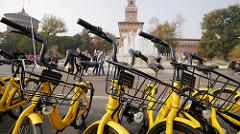- Topic
- Intermodality
- Mobility management
- Public and stakeholder involvement
- Urban mobility planning
- Walking and cycling
- Country
- Italy
- Resource type
- Case study
First published 12/04/2018
The city of Milan has just adopted its Sustainable Urban Mobility Plan after 3.5 years of preparation. The process involved several public consultations under the supervision of a Scientific Steering Committee. The SUMP is based on an appropriate Environmental Impact Assessment (EIA) and a Cost Benefit Analysis. The Plan aims at reshaping Milan’s overall mobility over the next 10 years, redefining the boundaries of the metropolitan city and serving large suburban areas.
Context
Milan is the second-most populated Italian city, with 1.35 million people in the city (about 7,400 habitants per km²) and about 3.2 million in its metropolitan area (about 2,000 habitants per km²).
Every day 850,000 people enter Milan and 270,000 exit the city – resulting in a total of 5.3 million trips per day. Although most people use public transport to get around Milan (57% of all trips in Milan are taken by public transport, 30% by cars, 7% by motorbike and 6% by bicycle), the city still has one of the highest European rates of car ownership (50.5 cars every 100 inhabitants compared to London 31, Berlin 29, Paris 25) and one of the highest concentrations of particulate matter among large European cities.
The issues of Milan’s mobility and transport system are the increase in private transport demand due to the functional separation between the city centre and the suburbs, road congestion, lack of planning of goods transport and logistics operations, and inefficient allocation of public space.
In action
The objective of the SUMP is to reach an optimal balance between efficient mobility demand, quality of life, environment and health protection. It required an integrated approach to mobility in order to:
• Decouple mobility needs and the use of private cars;
• Improve the quality of public space by reducing the share allocated to infrastructure;
• Ensure proper safety levels for pedestrians, cyclists and vehicles;
• Encourage, integrate and innovate low-impact transport services and modes;
• Encourage to share virtuous choices and behaviour;
• Develop practices of sustainable mobility and efficient use of energy resources;
• Use public resources efficiently.
Measures such as traffic calming, traffic reduction and shared mobility are core elements of the city strategy to improve the livableness of the city and the wellbeing of citizens and city users. For instance the new shared system “free floating”, operated by cars, bikes and scooters, is a fully integrated mobility system that supports both individual mobility and Local Public Transport, especially when allowing people to reach areas with a weak demand or uncovered by public transport and in a more comfortable way.
The city of Milan increased its bike lane network from 128 km in 2011 to 200 km in 2015, the Sustainable Urban Mobility Plan foresees a total of 453 km by 2024.
Another project conceived by the city of Milan to ensure stability to the whole shared mobility system is the developing and implementation of the so-called Mobility As A Service project (MaaS). MaaS Project objectives include socially inclusive and affordable access to mobility, fostering environmentally friendly mobility, supporting local transport offerings and introducing on-demand first/last mile services.
Results
The number of alternatives to private cars has risen : nearly 3,000 shared cars (27% fully electric) and more than 600,000 subscribers, 4,650 bikes (among which 1,000 e-bikes) from traditional station based bike sharing system and almost 60,000 yearly subscribers, 12,000 free-floating shared bikes since October 2017 and 100 fully electric shared scooters are currently circulating in Milan.
The success of Milan’s shared mobility is certified by a constant increase in the number of daily rentals. As for the car sharing, 15,340 are the average daily rentals and each shared vehicle is rented 5.6 times a day on average. The average duration of each rental is about 21 minutes and each car travels 6.21 km a day.
Moreover the car sharing contributes to reducing private car ownership: scientific studies have showed that, in the medium term, from 8 to 15 cars are removed from the streets for each available car-sharing vehicle.
According to the first data coming from the car sharing user’s survey, about 12% of respondents have already decided to give up their first or second private car, while about 8% is oriented to do so in the future (estimate reduction of 15,000 owner vehicles since the car sharing services have started in Milan).
As for the bike sharing, the last numbers recorded are: 280 stations; 3,650 traditional bikes; 1,000 electric bikes; 60,000 yearly subscriptions; more than 20,000 rents per day on average; 3,600,000 rents in 2016; 2,700,q000 Kg of CO2 saved in 2016.
Challenges, opportunities and transferability
As demonstrated by the selection of Milan among the three finalists for the 6th EU SUMP Award on the topic of shared mobility, the MaaS planning approach of Milan is considered by the jury of the award as very positive because it stimulates shared mobility. The jury also valued the stakeholder involvement and cooperative activity: it addresses citizen involvement, cooperation and co-creation at different levels and with different type of stakeholders, e.g. every new operator has the obligation to register and share data with the transport authority.
Additionally, the jury of the EU SUMP award appreciated that Milan is also working on clean vehicules with the promotion of electric cars and bikes.
In Depth
See the video on youtube: https://www.youtube.com/watch?v=xNj8YR-2GBM

